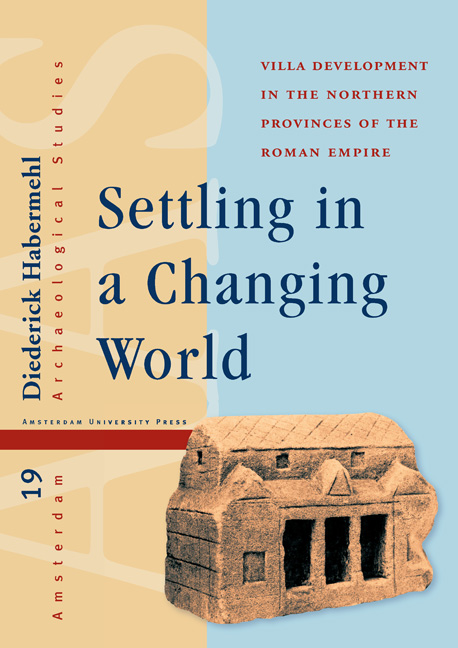Book contents
- Frontmatter
- Dedication
- Contents
- Preface
- 1 Introduction
- 2 Data and Research
- 3 Exploring Villa Development
- 4 Exploring the Social Villa. A Human Approach to Villa Development
- 5 Villa Development and the Organisation of Production
- 6 Settling in a Changing World: A Synthesis
- References
- Appendix 1 Site Catalogue
6 - Settling in a Changing World: A Synthesis
Published online by Cambridge University Press: 11 December 2020
- Frontmatter
- Dedication
- Contents
- Preface
- 1 Introduction
- 2 Data and Research
- 3 Exploring Villa Development
- 4 Exploring the Social Villa. A Human Approach to Villa Development
- 5 Villa Development and the Organisation of Production
- 6 Settling in a Changing World: A Synthesis
- References
- Appendix 1 Site Catalogue
Summary
This final chapter aims to provide a synthesis of the preceding study. On the one hand, the central phenomenon of ‘villa development’ is discussed in an integrated way, combining insights from the analyses and hopefully reaching a better understanding of these processes. On the other hand, the reconstructed processes are viewed from a wider perspective, embedding them in their broader context of the profound developments that accompanied the integration of this region into the Roman empire.
As elaborated in the introduction to this study, two main objectives can be identified. The first involves reconstructing, visualising and analysing development trajectories in settlement organisation and house building. The second is understanding these developments from a dimensional perspective, combining the short and the long term, local and global as well as social and economic perspectives and focusing on both structure and agency. The diachronic dimension is crucial, especially if we wish to shed light on processes of social and economic change within the context of the settlement and house. It is in this way that archaeology can greatly contribute to studies of the Roman past in ways that other disciplines cannot.
In this chapter I will review the results of these two objectives. The first part focuses on the variety in settlement development within the research region. The following section will present a coherent view on how we could interpret these developments socially. I then discuss in brief how villa development relates to processes of ‘becoming Roman’ that have been reconstructed in recent studies on the Roman provinces. Lastly, I will present some recommendations for future research.
Before starting, I should emphasise that the present study has set out to explore villa development. This takes it beyond the study of ‘the villa’ in a traditional sense, which is defined as a monumental house with strong Roman architectural inf luences or a settlement with such a main house. Taking a broader perspective, this study explores the complex of development processes within the rural settlements of the provincial countryside.
RECONSTRUCTING DEVELOPMENT TRAJECTORIES
Over the decades, large-scale excavations of rural settlement have led to a marked rise in settlement data, providing new potential for studying the organisation of wider settlement complexes and the diachronic dimension of both settlements and individual houses.
- Type
- Chapter
- Information
- Settling in a Changing WorldVilla Development in the Northern Provinces of the Roman Empire, pp. 157 - 166Publisher: Amsterdam University PressPrint publication year: 2013



